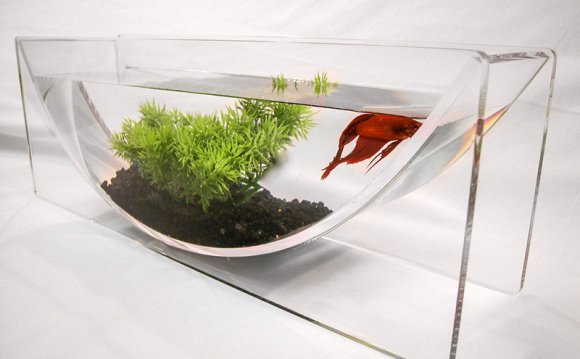
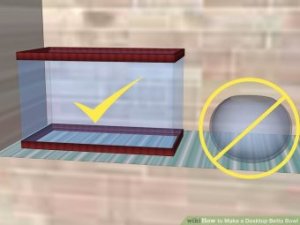
Steps
- Aquarium size Just because a betta can survive in a bowl so small it can't move doesn't mean it should be put in one.
- The tank size should be at least 3 gallons (11.4 L).
- Tank Placement. If you want a Betta tank as a display on a desk or table, place it away from drafts and direct sunlight. Also avoid areas above appliances or on top of places that are moved a lot (for example a filing cabinet).
- Filtration. Bettas, like all fish, need filtration. Small air-operated corner filters work great. Remember to cycle the filter before getting your fish.
- The following information applies if you do not have a cycled tank. Most betta keepers do not have a cycled fish tank and often keep betta fish in small bowls or tanks, this information is directed towards this type of fish keeper and is important to note:
- Betta fish need frequent partial water changes. Betta fish secrete ammonia at all times. This ammonia is invisible but deadly to betta fish. Not changing the water often enough is the number one cause of betta disease and death. NEVER change all of the water at once, it will remove all the beneficial bacteria, instead, do partial water changes. You can get a test kit for ammonia to monitor it (ammonia should never read about .25 ppm in a betta tank) OR you can follow the following guidelines:
- −3 gallon (−11.4 L) will need 25% water changes twice a week
- −5 gallon (−18.9 L) tank with filter will need 25%-50% once a week
- −10 gallon (−37.9 L) tank with filter will need 25% once a week
- Many care sheets given out by pet stores are wrong about the frequency of water changes.
 Because of this many betta fish languish and die in poor tank conditions because they are sold as low maintenance fish. This simply isn't true. *You can always do an ammonia test to be sure.
Because of this many betta fish languish and die in poor tank conditions because they are sold as low maintenance fish. This simply isn't true. *You can always do an ammonia test to be sure.
- Be sure to add a de-chlorinator (also known as a water conditioner) to the water, this will remove harmful chlorine that is in tap water that would kill your fish
- Be sure that the water you are changing is the same temperature as the old water the betta was in to avoid temperature shock which can be deadly to your betta. Use an in tank thermometer to check the water temperatures.
- Heating. Because Betta are tropical fish, they require a heater. The heater should be 5 watts per gallon. The temperature should be 75-80F.
- Lighting. Bettas don't require or prefer a lot of bright light; a regular room light is fine. Any light place above the bowl should be a few inches above so the Betta still has air, and should not be left on for more than 10 hours a day.
- 10
Substrate. A popular substrate is gravel and sand. Avoid anything too sharp that can tear your Betta's thin fins; if it can tear a pantyhose, it can tear your Betta's fins.
 11
Plants. Live plants make a great addition to a Betta aquarium. The best for live plants is Java Fern, don't let the plant take over all the space in the tank. Silk plants are also good.
11
Plants. Live plants make a great addition to a Betta aquarium. The best for live plants is Java Fern, don't let the plant take over all the space in the tank. Silk plants are also good.-
12
Cover. This is very important because Betta are great jumpers, A hood that has some plastic canvas allows the fish to breath and prevents him from jumping.
- 13 Keeping Your Aquarium Clean. For 5–10 gallon (18.9–37.9 L) aquariums 25% weekly water changes are important to keep the water clean and prevent diseases. More frequent changes of more water are needed for containers smaller than 5 gallons (18.9 L). Vacuum the gravel, but don't change out the filter media. Replace water with water of the same water parameters.
-
14
Setup your aquarium by placing your substrate, plants, heater, and filter. Add conditioned (with products such as Prime and Tank Buddies water conditioners) water and your Betta. -
15
Interacting with your friend. As time goes on you will learn your Betta's personality, likes and dislikes, favorite place to sleep, etc. Interacting with your pet could save his life, by observing him every day you will immediately recognize disease and treat pronto. Betta tend to be hardy but like all fish can get diseases.
Community Q&A
Add New Question
-
Can bettas get along with other fish?
wikiHow Contributor
It depends. You cannot mix a male betta with other bettas of either sex. Otherwise, they can get along with shrimp and Corydora catfish. You'll need a bigger tank for extra fish, though.
Ask a Question
If this question (or a similar one) is answered twice in this section, please click here to let us know.
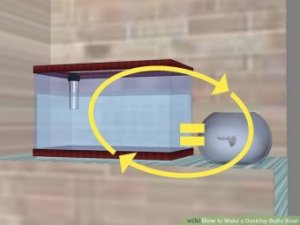
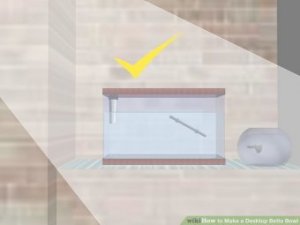
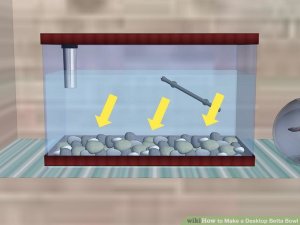
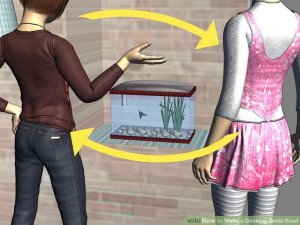
Source: www.wikihow.com









